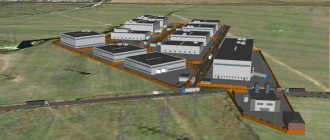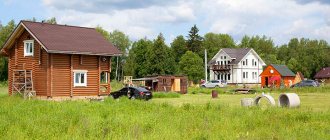Special purpose lands include territories allocated for the operation and maintenance of the activities of various industrial facilities, television and radio broadcasting, energy, communications, transport, as well as for the implementation of other tasks related to the targeted use of such lands. The legal regime and regulation of such territories is carried out by the Land Code of the Russian Federation (Articles 87-93), as well as special laws and acts of authorities.
Taking into account the nature of the tasks for which these territories were allocated into a separate category, the following lands for special and other purposes are distinguished:
- Lands of industry;
- Lands of communications, television and radio broadcasting, computer science;
- Earth to support space activities;
- Land Transport;
- Earth Energy;
- Lands of Security and Defense;
- Lands classified as other special purpose territories.
For the above industrial lands and other special purposes, a special regime of use is established. The need is that all objects of strategic, regional or national importance, which pose a danger to ordinary citizens or the impossibility of private use, can be used only for specifically designated purposes. Let's consider each category separately and determine their legal status.
Note that special-purpose lands are located outside populated areas, but may belong to various objects of municipalities or be in federal ownership or the property of constituent entities.
In accordance with Art. 87 of the Land Code of the Russian Federation, lands of industry and other special significance can be transferred for free use for agricultural production and other purposes.
What it is?
Industrial lands are land plots that are used by industrial enterprises or ensure the operation of their facilities for their intended purpose.
Industrial lands include areas recognized as unsuitable for agricultural activities, or areas with products of poorer quality or lack of fertile soil to begin with. This is the main reserve for the growth of industrial complexes.
Important! Industrial lands are located outside populated areas. A special sanitary zone is determined on their territory, and private lands located within their boundaries can be used by owners only subject to compliance with established restrictions.
Lands for industry and special purposes, which include areas for industry, are also divided into plots for space activities, energy, defense and security, transport and communications, which you can read about in our articles.
What do you need to know about changing the category of industrial land?
In order for the procedure to result in a category of industrial land, and for suitable types of permitted use to appear, it is necessary to study the provisions of the Land Code regarding the transfer of the territory to another purpose.
- If agricultural plots are transferred to the industrial category, it will be necessary to prove that they are of low value or completely unsuitable for agriculture.
- In some cases, it is necessary to apply for an environmental assessment and study the proximity of environmental and water protection zones.
- You will first need to request the current development and land use rules for this site, draw up a project for the future use of the site, approve the documentation and obtain the consent of local authorities.
- It is necessary to agree on the boundaries of the future land plot, carry out boundary work and other measures.
This procedure is quite complex, with many nuances and pitfalls. Even completing all registration actions without refusals or suspensions does not allow reducing the period for changing the category of a site to less than six months.
What is classified as industrial land?
In relation to Art. 88 of the Land Code of the Russian Federation, industrial lands include areas that are used or intended for:
- mineral extraction services provided by mining and oil and gas industry enterprises;
- enterprises of the chemical, manufacturing, metallurgical industries;
- lands occupied by factories, factories, quarries, mines, mines, mines;
- placement of industrial and administrative buildings, structures, structures and facilities serving them, in order to ensure the activities of organizations and the operation of industrial facilities.
Earth Energy
Energy lands are recognized as territories allocated for the operation and operation of energy facilities. According to the legislation of the Russian Federation, such facilities include federal energy systems, as well as nuclear energy facilities under the jurisdiction of federal authorities. This means that only state-owned organizations can be users of energy lands.
To ensure the life of energy facilities, land plots can be allocated for the location of nuclear and hydroelectric power plants, nuclear installations, thermal power plants, as well as for the placement of power lines, substations and other objects and buildings that ensure the functioning of the energy complex.
The procedure for identifying land plots for the placement of communication line supports and power lines is determined by Decree of the Government of the Russian Federation No. 486.
Protected zones of energy lands
Decree of the Government of the Russian Federation No. 160 defines the procedure for exploitation of protected zones of energy lands. The boundaries of the security zones are independently determined by the organizations that own the power grid (clause 6 of the Resolution). Within the security zones it is prohibited:
- Carry out any work that impedes the safe operation of the electrical grid;
- Place landfills;
- Dispose of caustic substances and weights exceeding 5 tons;
- Store fuels and lubricants;
- Place infrastructure facilities - markets, hospitals, parks, schools, etc.;
- Use aircraft (including kites);
- Planting and cutting down trees, working with soil (reclamation, blasting);
- Excavation work at a depth of more than 30 cm;
- Watering agricultural plants, provided that the water stream is more than 3 m;
A complete list of existing prohibitions can be found in Resolution No. 160.
Legal regime and position
The legal regime of industrial lands is a system of legal regulation of relations for the protection and use of these lands , aimed at ensuring the operation of industrial facilities.
Regulations are a set of established norms and rules that must be followed. The production activity of an industrial enterprise is a source of increased danger. The uniqueness of the legal regime of industrial lands is the establishment of sanitary protection zones, the purpose of which is to ensure the safety of the population and the environment from industrial waste.
Art. 42 of the Land Code of the Russian Federation obliges industrial enterprises:
- use land plots only for their intended purpose using methods that should not harm the environment;
- preserve geodetic, boundary and other special signs that are installed on land plots;
- implement measures to protect lands, forests, water bodies and other natural reserves, including fire safety measures, to prevent pollution, depletion, degradation, damage, and destruction of lands and soils;
- start using land plots in a timely manner (under a lease agreement);
- make timely payments for land.
Commentary on Article 87 of the Land Code of the Russian Federation
Lands for industry and other special purposes (as even the legislator himself calls this category for brevity, for example in paragraphs 2 - 6 of the commented article) are divided into several “subcategories of lands with a differentiated legal regime, which is due to the nature of the special tasks for which the data lands are used or intended for future use" <1>. ——————————— <1> Anisimov A.P., Ryzhenkov A.Ya., Chernomorets A.E. Commentary on the Land Code of the Russian Federation. Elista, 2006. P. 610.
These subcategories are listed in paragraph 2 of the commented article, and a separate article of this Code is also devoted to each of them. Of particular interest is sub. 7 clause 2, which talks about lands for other special purposes. The presence of such wording makes the list of subcategories open and not exhaustive.
The literature notes that other special-purpose lands may include burial sites for nuclear and other waste <1>, lands provided for use by the state observation network, which operates in accordance with Federal Law of July 19, 1998 N 113-FZ “On the hydrometeorological service” <2>, and other land plots. ——————————— <1> See: Land Law: Textbook / Ed. S.A. Bogolyubova. M.: TK Velby, 2002. P. 321.
<2> See: Krassov O.I. Commentary on the Land Code of the Russian Federation // ATP “Garant”.
In Art. Art. 87 - 93 of the Land Code of the Russian Federation, both after the general characteristics of lands of this category and after defining each of the subcategories, it is said that these are lands the rights to which have arisen among participants in land relations on the grounds provided for by this Code, federal laws and laws of constituent entities of the Russian Federation <1> . It seems that even a single entry in Art. 87 of the Land Code of the Russian Federation would be redundant, since rights to land plots always arise on the grounds provided for by law, and, in addition, the Code has a special chapter “The emergence of rights to land”, which applies to all categories of land. Repeating this formulation seven times is all the more unjustified. ——————————— <1> In relation to defense and security lands, the laws of the constituent entities of the Russian Federation are not mentioned, i.e. We are talking only about the Land Code of the Russian Federation and other federal laws.
The commented article specifically emphasizes that industrial and other special purpose lands include only lands located outside populated areas. If industrial, transport, defense and other similar enterprises (organizations) are located in cities, then the legal regime of the land plots on which they are located is subject to the regime of the corresponding territorial zone within the populated area.
In this category of lands, a large share is occupied by lands that are federal property. They are listed in paragraph 4 of the commented article. According to Art. 27 of this Code, many of these lands are withdrawn from circulation <1>. ——————————— <1> According to the Federal Law of July 2, 2013 N 142-FZ, the category of objects of civil rights withdrawn from circulation from clause 1 of Art. 129 of the Civil Code of the Russian Federation is excluded. Now objects of civil rights are divided into only two groups: those in free circulation and those limited in circulation. However, Art. 27 of this Code has not yet been brought into conformity with the Civil Code of the Russian Federation.
It should be noted that a large number of legal disputes arise in connection with the ambiguous interpretation of the legislation specifically in relation to land plots occupied by industrial facilities, transport infrastructure facilities, defense facilities, etc. in populated areas, including on issues related to determining the subject of ownership of land plots occupied by these objects.
These disputes arise with enviable regularity, which indicates the urgent need for a clearer regulation of this issue directly in the law. The practice of considering this type of dispute will be discussed further in relation to individual subcategories of land in this category. Here we note that when making decisions in such cases, courts constantly refer to Art. Art. 87 - 93 of the Land Code of the Russian Federation, which, in our opinion, is incorrect, since we are talking about land plots belonging to a different category of land.
Citizens and legal entities should keep in mind that the use of land plots of this category must be carried out in compliance with the rules established for the corresponding subcategory, otherwise it will be considered an offense.
In particular, an inspection of the territorial department of Rosnedvizhimost in the Perm Territory revealed that the land plot provided to an individual entrepreneur with permitted use for industrial enterprises on industrial lands is actually used for motor transport facilities (the construction of a security point and a parking lot), which is a violation of Art. 42 of the Land Code of the Russian Federation.
The entrepreneur was issued an order requiring him to eliminate the violation by using the land plot in accordance with its intended purpose or changing the permitted use. The entrepreneur’s attempt to appeal this order was unsuccessful, since the courts came to the correct conclusion that, despite the fact that industrial lands and transport lands belong to the same category of lands of the Russian Federation (special purpose lands), the regime and type of permitted use of these lands are different, therefore , the requirements of the government agency are legal <1>. ——————————— <1> Resolution of the Federal Antimonopoly Service of the Ural District dated May 11, 2010 N F09-3256/10-S1 in case N A50-33592/2009.
Since the activities of industrial enterprises and other facilities for which these lands are provided may pose a danger to the population, this category of land may include security, sanitary protection and other zones with special conditions for land use.
Conversely, economic activities within such zones may cause harm to protected objects or significantly impede their operation, so certain types of activities that are incompatible with the purposes of establishing zones may be limited or prohibited.
The creation of sanitary protection zones around objects of economic and other activities that have a negative impact on the environment in order to protect atmospheric air and living conditions of the environment is provided for by Federal Laws of January 10, 2002 No. 7-FZ “On Environmental Protection” and from May 4, 1999 N 96-FZ “On the protection of atmospheric air” and other acts.
Federal Law of July 13, 2015 N 252-FZ “On Amendments to the Land Code of the Russian Federation and Certain Legislative Acts of the Russian Federation”, the commented article was supplemented with three new paragraphs - 5.1 - 5.3, specifying the procedure for establishing zones with special conditions for the use of the territory (in part of the information about the boundaries of such a zone and a description of their location, as well as the deadlines for notifying rights holders of land plots included within the boundaries of a zone with special conditions for the use of the territory about restrictions on the use of land plots within the boundaries of such a zone). These additions came into effect on January 1, 2021.
By the same Law Art. 15 of the Federal Law “On the State Real Estate Cadastre”, dedicated to information interaction in the maintenance of the State Property Committee, was supplemented by the provision that a mandatory annex to the decision of a state authority or local government on establishing or changing the boundaries of a zone with special conditions for the use of territories, sent to the authority cadastral registration are electronically prepared text and graphic descriptions of the location of the boundaries of a zone with special conditions for the use of the territory, a list of coordinates of characteristic points of the boundaries of such a zone (the norm came into force on January 1, 2021).
Law N 252-FZ introduced amendments to the Town Planning Code of the Russian Federation (Article 55), providing that in order to issue a permit for the commissioning of a capital construction facility that is an electric power industry facility, a gas supply system, transport infrastructure, pipeline transport or communications, if for the operation of this object, in accordance with federal laws, the establishment of a protective zone is required; the obligatory document attached to the application for the issuance of such a permit is text and graphic descriptions of the location of the boundaries of the protective zone prepared in electronic form, a list of coordinates of characteristic points of the boundaries of such a zone. The location of the boundaries of such a zone must be agreed upon with the state authority or local government authority authorized to make decisions on the establishment of such a zone (the boundaries of such a zone), except for cases where these authorities are the authorities issuing permission to put the facility into operation.
The text and graphic descriptions of the location of the boundaries of the protective zone, the list of coordinates of characteristic points of the boundaries of such a zone, submitted by the applicant, are a mandatory appendix to the permit to put the facility into operation. Moreover, this permit is simultaneously a decision to establish a security zone for the specified object.
These rules come into force on January 1, 2021, therefore, applications for permission to put a facility into operation submitted before this date do not apply.
The requirements for the coordinate system, the accuracy of determining the coordinates of characteristic points of the boundaries of a zone with special conditions for the use of the territory, the format of the electronic document containing information about the boundaries of the zone with special conditions for the use of the territory, are approved by Order of the Ministry of Economic Development of the Russian Federation of March 23, 2021 N 163.
Information about the location of the boundaries of zones with special conditions for the use of the territory must be entered into the state real estate cadastre before January 1, 2022 (Part 2 of Article 5 of Law No. 252-FZ).
The provision of paragraph 5.2 of the commented article regarding who should carry out the activities to establish the boundaries of these zones seems important. Previously, disputes arose on this issue in judicial practice <1>. Thus, the Decree of the Administration of the Bolsheuluisky District of the Krasnoyarsk Territory dated June 14, 2006 N 159 established the sanitary protection zone of the Achinsk Oil Refinery of the Eastern Oil Company OJSC (hereinafter referred to as the company) with the imposition on the company of the obligation to register the land survey of the land plot on which the sanitary protection zone, and its delivery for cadastral registration. ——————————— <1> See, for example: Resolution of the Presidium of the Sverdlovsk Regional Court of August 18, 2010 in case No. 44-G-26/2010.
The company appealed to the arbitration court with a statement to declare the relevant paragraph of the district administration’s resolution illegal. By decision of the Arbitration Court of the Krasnoyarsk Territory dated December 30, 2008, the stated claims were denied. By the decision of the Third Arbitration Court of Appeal dated March 10, 2009, the court decision of December 30, 2008 was canceled, and a new judicial act was adopted satisfying the applicant’s demands. The appellate instance came to the conclusion that there is no provision in the current legislation providing for the carrying out of boundary work to establish the boundaries of the sanitary protection zone, and also noted that the right holder or the state (municipal) body to which the right holder or the state (municipal) body, to which society does not apply.
The Federal Arbitration Court of the East Siberian District <1> agreed with this approach, pointing out that legal entities are obligated to comply with the regime of the sanitary protection zone, and not to carry out work on surveying the land plot covered by the sanitary protection zone. The company is not the legal holder of the land plot covered by its sanitary protection zone, and therefore the application and documents for state cadastral registration of land plots are submitted by the interested legal holder or state (municipal) bodies. ——————————— <1> See: Resolution of the Federal Antimonopoly Service of the East Siberian District dated July 2, 2009 N A33-13282/08.
Now, according to clause 5.2 of this article, the preparation of text and graphic descriptions of the location of the boundaries of a zone with special conditions for the use of the territory and a list of coordinates of characteristic points of the boundaries of such a zone is provided by the copyright holders of the specified objects or other persons on the basis of an agreement with such copyright holders, i.e. under this rule, imposing such a duty on society would be legal.
In pursuance of clause 5.3 of the commented article, the Decree of the Government of the Russian Federation of July 12, 2021 N 662 approved the Rules for notifying rights holders of land plots included within the boundaries of a zone with special conditions for the use of the territory about restrictions on the use of land plots within the boundaries of such a zone.
According to these Rules, informing the right holders of land plots about restrictions on the use of land plots within the boundaries of the zone is carried out within 15 days from the date of entry into the state real estate cadastre of information about the establishment of the zone by sending a notification either to the e-mail address of the right holder or to his postal address.
The notice shall contain the following information:
a) the name of the state authority or local government body that made the decision to establish the zone, the details of such a decision;
b) the date of entry into the state real estate cadastre of information about the establishment of the zone;
c) individual designation (type, type, number, index, etc.) of the zone;
d) description of the location of the zone boundaries;
e) content of restrictions on the use of real estate within the boundaries of the zone;
f) cadastral numbers of land plots included within the boundaries of the zone and belonging to the copyright holder.
Who is the owner?
The owners of the plots can be:
- Individuals.
- Legal entities.
- Federal government.
- Regional government.
- Municipalities.
Attention! Land plots within which there are mineral deposits cannot be privately owned. Deposits in the Russian Federation are state property. Therefore, such lands can only be provided on the basis of the right of use, including lease.
Types of permitted and prohibited use of land plots
Types of permitted use of land plots that are not subject to urban planning regulations are determined on the basis of the State Real Estate Cadastre.
The State Real Estate Cadastre is a collection of information about registered real estate and the State borders of settlements, municipalities, and zones with special operating conditions. Order of the Ministry of Economic Development of Russia dated September 1, 2014 No. 540 “On approval of the classifier of types of permitted use of land plots” approved the corresponding classifier containing a list of permitted types of use, including codes for them, which are applied throughout the Russian Federation. Industry, codes 6.2.- 6.6.:
- heavy 6.2. (mechanical engineering, metallurgy, mining, when it is necessary to introduce special zones);
- easy 6.3. (production of textiles, clothing, ceramics);
- food 6.4. (baking, drinks, canning);
- petrochemical 6.5. (processing of raw materials, household chemical products);
- construction 6.6. (production of bricks, cement, elevators, fasteners).
Reference. According to Art. 14 of the Land Code of the Russian Federation, land plots that have been contaminated by chemical or radioactive substances, as well as the structures located on them, are used in the manner determined by the Government of the Russian Federation.
On such lands and land plots the production and sale of agricultural products is prohibited . Failure to comply with the law will result in fines and penalties.
Earth transport
The category of transport lands includes territories allocated to support the activities and operation of railway, road, sea, air and other types of transport, defined by the land legislation of the Russian Federation.
Railway lands
Thus, railway transport lands may include the following categories:
- areas for placing railway tracks;
- areas for the placement and operation of buildings and structures - stations, stations, repair depots, buildings, devices and structures necessary for the functioning and operation of railway transport;
- right-of-way and special security zones that are provided to citizens for servicing railway transport, providing services to passengers, etc. This includes warehouses, gas stations, unloading areas, as well as warehouses intended for storing items and objects with a special status of legal regulation;
In accordance with Order of the Ministry of Transport No. 126 and Law No. 17-FZ, right of way can be established on railway transport lands - land plots that are adjacent to the railway tracks, as well as areas for the location of stations, communication lines, protective forest belts, as well as other railway facilities d transport.
Land plots within the right of way can be leased to individuals and legal entities for agriculture, cargo storage, provision of services to railway passengers, as well as for other purposes that do not interfere with traffic safety.
Road transport lands
Motor transport lands include areas allocated for the operation and maintenance of federal highways, as well as roadside strips with a special regime of use.
For motor transport lands, as well as for railway transport lands, right of way and roadside strips are established. According to Art. 90 of the Land Code of the Russian Federation, to ensure road traffic on rights of way, land plots can be transferred to individuals and legal entities. It is allowed to place road service facilities in such areas.
Within the boundaries of the highway right of way it is prohibited:
- place buildings and other objects not intended to serve the highway
- plowing land, mowing grass, cutting trees, grazing and driving animals
- installation of advertising structures that do not comply with technical regulations
- installation of information boards and signs, if they are not related to road safety.
Land plots that are intended for the placement of road service facilities and the installation of advertising structures can be provided to citizens and legal entities for these purposes. Clause 4 art. 25 of Law No. 257-FZ establishes that land plots can be transferred under the terms of a public or private easement. Such plots are located on public lands and are assigned to departmental organizations, and therefore the use of classical lease is impossible. The provisions on the use of easements, as well as their application, are in the Civil Code of the Russian Federation. Let us note that the classical understanding of an easement (providing passage or travel through a certain territory, construction work on linear objects) is not applicable in this case - easements are established only for the construction and operation of road service facilities. The terms and conditions for using the site are specified in the easement agreement.
Lands of water and sea transport
For the full functioning of maritime and water transport facilities, the following land plots are allocated:
- for placement and creation of artificial waterways;
- for the placement of facilities necessary for the operation and functioning of sea and water transport - ports, stations, berths and other buildings and structures of water and sea transport;
- for placing sections of the shoreline.
In accordance with the Water Code of the Russian Federation, sections of the coastal strip are established on the territory of the land of water and sea transport. A shoreline is a strip of land that runs along the boundary of public water and is intended for public use. The standard length of the shoreline is 20 meters, with the exception of the shorelines of canals and rivers, the length of which is less than 10 kilometers - in such cases the size of the strip is 5 meters. Privatization of land plots within the coastal strip is prohibited. The coastal strip of inland waterways is allocated for work related to navigation and rafting on inland waterways, outside the territories of populated areas.
Air transport lands
For the operation of air transport, land is allocated for airports, runways, airfields, train stations, as well as other real estate necessary to ensure the proper operation of air transport.
Construction of production facilities
What can and cannot be built?
Allowed to build:
- industrial buildings (plants, factories, production workshops);
- cultural and community premises (sanitary, medical, educational institutions, public catering premises);
- other structures (warehouses, utility rooms);
- water bodies (ponds, pools with retaining structures on water outflows).
Forbidden:
- individual residential buildings (residential buildings, apartments);
- personal subsidiary farming (vegetable gardens: growing agricultural products);
- country buildings (baths, woodsheds, sheds);
- other structures that contradict the intended purpose of the land plot (animal enclosures).
Important! If residential development takes place in an area with restrictions on the exploitation of the site, it is possible to change the category of land from industrial to agricultural land or populated areas.
What is required for construction?
According to Federal Law No. 218-FZ dated July 13, 2015 “On State Registration of Real Estate,” the following documents are required for the construction of a facility:
- A document establishing the right to own a plot of land.
- Technical plan of the land plot.
- Construction permit (issued according to the documents of paragraphs 1 and 2, issued by the local government body at the location of the site - part 4 of article 51 of the Civil Code of the Russian Federation).
- Technical plan of the structure.
Industrial land tax
Just like lands for other designated purposes, industrial land is subject to tax. The maximum tax rate on it is 1.5 percent of the cadastral value, which significantly exceeds taxes on other territories. The price per hectare also depends on the territorial direction, whether the site is far from populated areas. Are there communications, useful properties of the land, what region of the state does it belong to? Most often it happens that the amounts are inflated due to the cadastral value. But you have the right to challenge the tax by going to court.
Management and monitoring
Art. 67 of the RF Land Code provides for state monitoring of lands. The effectiveness of the management activities of an industrial enterprise directly depends on timely and reliable information about the functioning and economic condition of the organization.
Attention! Monitoring as a means of obtaining statistically reliable information and drawing up short-term and long-term forecasts is necessary for high-quality management of the process of sustainable development of an enterprise.
Industrial land monitoring allows you to:
- predict profitability;
- innovative development;
- solvency and liquidity;
- determine financial stability;
- business activity of the enterprise.
In addition, land monitoring motivates industry; timely strengthening of vulnerable areas helps prevent errors , which contributes to the development of the enterprise.
Methods of state cadastral valuation
Decree of the Government of the Russian Federation dated April 8, 2000 No. 316 “On approval of the Rules for conducting state cadastral valuation of land”, clauses 6.1. – 6.3. establishes the assessment procedure for industrial lands:
- Determination of specific indicators of the cadastral value of land plots: calculated based on the values of specific indicators of the cadastral value of land plots of the category and (or) type of use bordering the specified land plots.
- Calculation of the cadastral value of land plots: determined by multiplying the specific indicators of the cadastral value of the specified land plots by their area.
Cost calculation
Cadastral value is a conditional monetary value, intended mainly for calculating tax. Cadastral registration in the Russian Federation is regulated by the laws “On cadastral activities” dated July 24, 2007 No. 221-FZ and “On state registration of real estate” dated July 13, 2015 No. 218-FZ.
An example of calculating cadastral value.
Calculation of KS is a complex process. You can preliminary estimate the CS of a site using a simplified formula:
KS=PL*(KI+KL)*KP , where:
- KS (rub.) – cadastral value.
- PL(m2) – area of the plot.
- KI, KL (rub./m2) – infrastructure and specificity coefficients.
- KP – transition coefficient.
According to the regulations of Rosreestr, the calculation of the KS of land plots is carried out at least once every 5 years and no more often than after 3 years. The necessary coefficients for preliminary calculation can be obtained from professional appraisers.
Regime of use of transport lands
Land classified as railway traffic may be leased for a long term. As a rule, a lease agreement is concluded with entities conducting business activities. In this case, the following conditions are put forward:
- no negative impact on the site;
- ensuring safe movement of railway transport.
On lands belonging to the group of highways, the construction of buildings related to automobile service facilities, gas stations and food outlets is permitted. Installation of unsafe information signs is strictly prohibited. It is also impossible to build structures and structures in such an area that are in no way related to supporting road needs.
In the area of water lands, the construction of berths, marinas and ports is allowed. Additionally, it is permitted to carry out measures to develop a coastal protection strip, as well as the creation of artificial reservoirs. Privatization of coastal land is prohibited in accordance with current Russian laws.
For the lands on which pipelines are located, certain safety zones are also provided, the size of which depends on the nature of the purpose of the facility.
Is it possible to rent or transfer into ownership and under what conditions?
The following agreements may apply to industrial lands:
- purchases and sales;
- rent;
- free use;
- donations and other permissible agreements relating to real estate.
- no impact on industrial lands is possible if international agreements are implemented;
- reconstruction or construction of federal (local) defense, security, energy, transport and other communications facilities is taking place;
- if the plot is seized in accordance with a court order;
- in the presence of other justified reasons that do not contradict federal legislation.
Features and rental procedure
Renting from a private person:
- Find an owner with a suitable land plot.
- Determine the subject of the relationship, price, rental period and sign the agreement in 2 copies for each party. If the lease exceeds 12 months, registration is required with Rosreestr.
Renting from the municipality:
- Submit an application to the administration that owns the land.
- Submit an application to participate in the auction.
- Make a fixed deposit, which is returned if you lose at the auction.
- Sign the appropriate agreement with the municipality.
Required documents:
- Identity document for an individual.
- Extract from the Unified State Register of Individual Entrepreneurs or the Unified State Register of Legal Entities for individual entrepreneurs and legal entities.
- Application in the prescribed form.
- Cash document confirming payment of the deposit.
For registration in Rosreestr:
- Application from the landlord.
- Resolution of the administration on the allocation of the site.
- Tenant's identification documents.
- Three signed copies of the agreement.
- Constituent documents for the land plot.
- Receipt for payment of state duty.
Structuring of industrial and special purpose land
Land plots for industrial and special purposes are divided into categories depending on their purpose and use:
- Lands related to the energy sector - power plants, electrical transmission lines.
- Transport lands - railway communications complexes, road communications, sea communications, pipelines.
- Lands for communications and information television broadcasting, as well as radio broadcasting - structures and complexes for ensuring the operation of satellite systems and technical maintenance of communication lines.
- Areas for space work - cosmodromes, testing grounds, launch pads, training centers and preparation sites.
- Territories intended for defense. For example, a test site, a military unit, all kinds of classified objects.
- Land with other special purposes - cemetery, hospital, sanatorium, animal farm, etc.
The ratio of lands for industrial and other purposes is clearly demonstrated in the following table:
| Connection | 0,2% |
| Space | 0,07% |
| Transport | 13,5% |
| Energy | 0,9% |
| Industry | 12,1% |
| Defense | 69,0% |
| Other | 4,3% |











